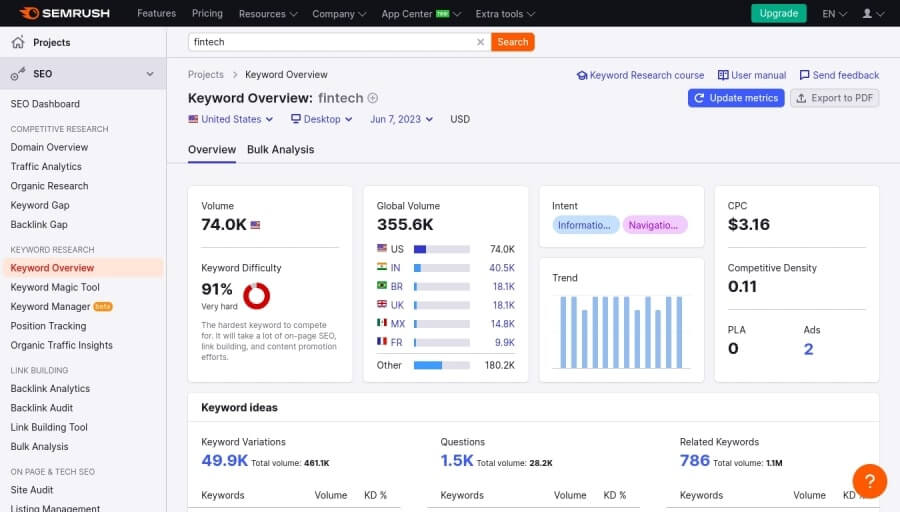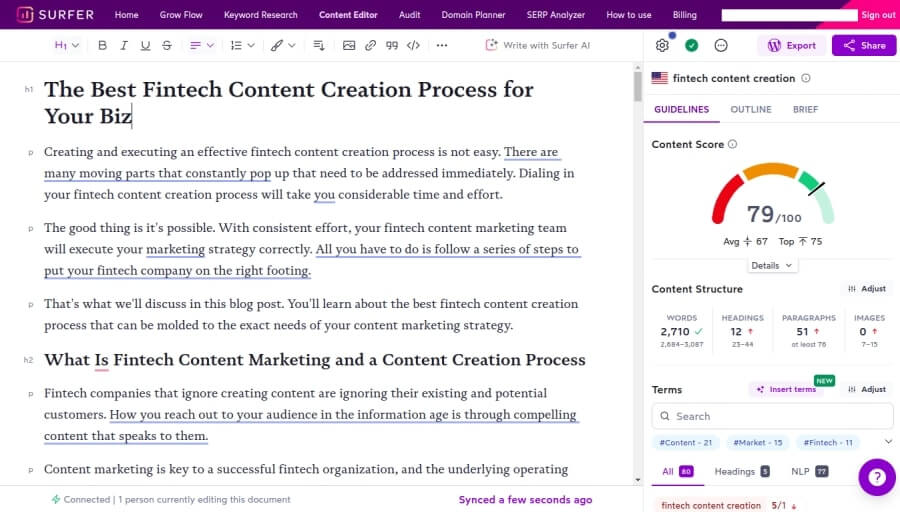9 Steps to Master Fintech Content Creation


Creating and executing an effective fintech content creation process is not easy. There are many moving parts that constantly pop up that need to be addressed immediately. Dialing in your fintech content creation process will take you considerable time and effort.
The good thing is it’s possible. With consistent effort, your fintech content marketing team will execute your marketing strategy correctly. All you have to do is follow a series of steps to put your fintech company on the right footing.
That’s what we’ll discuss in this blog post. You’ll learn about the best fintech content creation process that can be molded to the exact needs of your content marketing strategy.
What Is Fintech Content Marketing and a Content Creation Process
Fintech companies that ignore creating content are ignoring their existing and potential customers. How you reach out to your audience in the information age is through compelling content that speaks to them.
Content marketing is key to a successful fintech organization, and the underlying operating system that ensures that success is a streamlined content creation process. Just like how a manufacturing facility needs to have a well-structured, efficient operational workflow, the same goes for creating content that’s actually good. Over 60% of successful marketers have a documented content marketing strategy they execute like clockwork.
Here are the key elements that fintech content marketing teams need to implement:
- Plan and research your content marketing strategy
- Generate high-quality content ideas
- Create high-quality content
- Include appealing visuals
- Review the fintech content being created
- Optimize your content for search engines and social media
- Publish helpful content that reaches your target audience
- Improve and fix issues in the process of producing content
Now you know the importance of fintech content marketing and the process of creating content. Now let’s dive into the details of creating content using a process that’ll ensure your fintech marketing strategy is executed correctly.
The Best Fintech Content Creation Process: 9 Steps to Follow
Content marketing strategies mean nothing if they’re not executed properly. Wasting your marketing resources by not having a dialed-in operational system to produce quality content will only hurt your fintech company.
Fintech companies following these steps will create high-quality content regularly, resulting in increased brand awareness, increased brand authority, increased website traffic, and will, ultimately, increase conversions.
Step 1 - Plan and Research Your Fintech Content Marketing Strategy
Before writing content, you need to plan and research your content. This can mean many things, but the most important is knowing what your audience wants to consume and how to give it to them.
An effective fintech content marketing strategy will also have clearly defined goals and objectives. Are you looking to drive organic traffic? You need to invest in content marketing and SEO. Are you looking to boost your brand awareness quickly? You need to invest in social media marketing. Clearly defined goals and objectives will steer your planning to a research phase.
The next thing you need is to perform keyword research. No one will find your fintech company if your target audience is searching for “fintech lending platforms” and you are not using those keywords on your site (if that’s your business!). From short-tail to long-tail keywords, find high-intent keywords your audience is searching for and fill in the gaps with good content.

With all of this done, it’s now time to create an editorial calendar. This will direct your content operations and ensure it’s delivering good content on a regular basis across all of your channels. Without this, you’re just hoping you hit your targets.
Step 2 - Generate Good Ideas for Your Fintech Content Regularly
The planning and research phase leads into the content idea generation phase. Some of what you did previously still needs filling in (e.g., your editorial calendar), which is why brainstorming content ideas that align with your keyword research, goals, audience, and channels is key.
Good content ideas are one thing, but you must also create outlines across your content formats. Blog posts, video scripts, website copy, whatever. Having an outline that your team agrees on is incredibly important because you don’t want your writing team to guess what exactly to write about. An outline takes the guessing variable out of the equation.
Your fintech writer will perform a lot of research and information gathering, but you, as a company, should provide them with as much information as you possibly can. While it’s their job to do this, the more ammunition you can give them with respect to your business, audience personas, internal documents, etc., will have a major impact on the quality of your writer’s content.
Last but not least, when asking your writers to create content to your exact specifications, you must do so with a well-written content brief. This brief is almost like a contract ensuring what you asked for is what will be delivered. This benefits both your company and your writers. Each piece of content must have a content brief.
Step 3 - Get To Writing and Editing Good Content
Now it’s time for the fun part: writing. Crafting engaging and well-structured content is the job of your fintech content writer, and if you did enough up-front work to enable them to succeed, everyone will succeed.
An important piece of creating and editing fantastic content is incorporating good structure. This should’ve been ironed out during the outline creation, but it’s very important the writer is aware of how to deliver the content well in the outline provided. For example, you don’t want walls of text, a lack of transitions, or uninteresting headings.
Obviously, I’m going to say that everything in this blog post is important, but this is probably one of the most important takeaways. Incorporate SEO by following SEO best practices. Your writer and editor don’t have to be SEO wizards, but using keywords in the right places, creating good meta descriptions, proper formatting, and much more should be incorporated.

The last piece of the puzzle is having a good review and proofreading process. This is to keep your content not just accurate and clear but also to keep a consistent brand voice. Honestly, this is one of the more difficult aspects of executing an effective content marketing strategy. The reason is it can’t be learned outside of your organization. Your writers and editors need to learn it from you, and that means being active in the content creation process.
Step 4 - Sprinkle in Some Visual Elements That Help Your Audience
Executing a high-quality content marketing strategy means delivering your message effectively in every medium. Like the financial services industry, fintech companies have a tough time communicating with their target audience at times because the product or service offerings can be technical and complex.
Fintech companies that use relevant visuals, like infographics, GIFs, and videos, will have a better time acquiring potential customers. I’m definitely guilty of not doing this enough, but content marketing is much more than writing because content comes in many forms.
Your content strategy should also incorporate podcasting. Not surprisingly, podcast listeners have grown 29.5% since 2020. Spending money on a content marketing strategy that effectively delivers podcast content will likely be well spent.
An important note to make is that you have to be sure your brand is consistent across different media. It’s easy for teams producing content to silo a bit to where they’re not 100% in-tuned to each other’s channels. Ensure everything being created and published is on-brand and aimed at achieving the goals and objectives laid out by your fintech marketing strategy.
Step 5 - Don’t Skip the Review and Approval Process
Good content marketers who publish content regularly know that performing quality assurance is a must. A content strategy that doesn’t include an internal review process outputs lots of content that’s potentially poor in quality and will not achieve any goals. Whether you’re creating content yourself or with a content marketing agency, it’s your company’s responsibility to review and approve what gets published.
Content marketing strategies that work well must have feedback from stakeholders. The fintech industry can get complicated, so having subject matter experts, a thought leader or two, data-driven insights, and high-level marketing team members reviewing (and, ideally, revising) content is key.
Creating fintech and financial content that produces brand awareness and drives traffic requires interesting content and accurate content. Building trust from your audience for your fintech business means offering them helpful content that’s both fun and informative. It’s not one or the other; it’s both, regardless if you’re target persona is an executive or casual app shopper.
Iterating and refining your content based on feedback is going to have a positive effect on your content marketing efforts. Ensuring all content going out the door, including how-to guides, social media posts, long-form content, infographics, and more, is accurate, on-brand, and, most importantly, interesting.
Step 6 - Optimize the Distribution of Your Content Across Multiple Channels
Content takes many forms and should fit the channel it’s being distributed through. You wouldn’t use the entire content of a blog post in a tweet. Knowing about your distribution channels goes hand in hand with knowing your audience. That’s why adapting your content marketing strategy for various distribution channels, including your website and social media accounts, is necessary.
Repurposing content is a great way to ensure everything your writers produce gets to as many people as possible. An effective way to go about this, from my experience, is to expand your content outward from your long-form content. For example, if you write a blog post every week, have your social media content “rhyme” with your blog content. This’ll keep your messaging consistent and it’ll save money and time.
Once you have content that can be pushed out to multiple channels, you want to optimize that content for discoverability. That means search engine optimization (SEO) must be ingrained in your fintech marketing strategy, particularly implementing SEO techniques for Google, Twitter, LinkedIn, and other channels. With 68% of online experiences beginning with a search engine, you can’t afford to skip this.
It’s not uncommon for content to look great before optimizing for SEO and coming out a little differently. While ensuring your content is SEO-optimized is extremely important, the content you publish must flow well. Your team needs to format the content to enhance readability and user experience.
Step 7 - Publish Your Content and Promote the Heck Out of It
Implementing an effective content marketing strategy requires actually publishing content on a regular basis. This is the biggest issue I see with fintech companies. Your content marketing efforts won’t produce results if you don’t consistently write and publish content.
Depending on what platform your fintech business is built on, uploading your content will differ. The most common content management systems (CMS) I see fintech companies use include:
- WordPress
- Ghost
- Webflow
- Jekyll
- Strapi
Some fintech companies have their fintech app running on the same platform as their content management system (usually because the CMS is headless), so how you upload your content can differ greatly in the fintech space.
As you publish, remember you want to attract that potential customer and drive sales. The only way you can achieve that is by getting future customers to click on your links, whether on Google or social media. That’s why having enticing but accurate headlines and meta descriptions is so important. Good copywriters who can write this content for your business will increase click-through rate and, ultimately, increase conversions.
Becoming a thought leader in your space means having your content show up everywhere. Be sure to share your content across as many relevant channels as possible, whether through your blog, social media accounts, newsletter, email marketing efforts, etc. This is incredibly important for brand awareness.
Content marketing in the fintech space is increasingly competitive, so standing out requires a lot of effort. An effective way to stand out to your audience is by engaging with them as they engage with your content. That means responding to comments on social media, replying to people emailing you after sending your newsletter, and any other marketing channel you can think of.
Step 8 - Keep an Eagle Eye on Your Analytics
Leveraging analytics platforms, like Google Analytics, Google Search Console, Mixpanel, Amplitude, and others, will tremendously help your fintech content marketing efforts if used correctly. You can publish content that you think is great until the end of time, but if it’s not performing well, there’s no point. You’ve got to measure the effectiveness of your content.

Content marketing teams must track key performance indicators (KPIs) that show how well their content performs. If you’re not doing this, you’re potentially publishing into the void. Google Analytics is a great tool to use and can help you monitor the most important metrics
Some of the most important metrics you should be monitoring include:
- User count
- Page views
- Bounce rate
- Average time on page
- Conversion rate
- Channel distribution
- User demographics
While you don’t want to adjust your content marketing strategy to the daily swings of these metrics, taking a data-driven approach over a long horizon can help steer your strategy. I’m focusing on website traffic and analytics in this blog post because that’s mostly what I do, but some of these metrics are also used for social media and across other channels.
If your analytics platforms show that some content is working better than others, adjusting your content marketing strategy a bit is wise. It can be tough sometimes to know what kind of financial technology content your customers want, so use these tools to your advantage. If you notice a particular topic cluster is getting more page views and/or average page time than others, that’s a clear sign you need to produce more of that type of content.
Step 9 - Continuously Improve Your Content Creation Process
Last but not least, to ensure your fintech content marketing strategy is operating at its best and helping your fintech company reach its goals, you must improve continuously. My experience executing six sigma strategies taught me the word Kaizen, a Japanese word meaning “continuous improvement.” Your content marketing strategy needs this.
A great way to continuously improve is to conduct regular audits on your content marketing efforts followed by an analysis. A content audit is something every content marketing team should be implemented regularly, as well as an SEO audit. Combining both will ensure your content marketing strategies are dialed-in and working effectively.
The best companies in the fintech industry know customer acquisition and lead generation are key. An incredibly valuable technique to make sure both of those are humming along nicely is to get regular feedback from your audience. This will improve your marketing strategies as well as your conversion rates if done correctly and regularly.
Continuous improvement also means testing new audiences, content formats, and content strategies. Using a simple method like A/B testing, which over 70% of companies do A/B tests on their websites, will help your company know exactly what your customers are looking for, how best to draw them in, and how best to keep them. This can improve conversion rates and, ultimately, improve your company’s buying process.
Creating good fintech and financial content means staying on top of the latest trends in the fintech industry. Following best practices in the ever-changing marketing space and new, innovative strategies will give fintech companies an edge and, ideally, bring in more customers.
Final Thoughts
Fintech content marketing isn’t much different than other types of content marketing. Understanding that producing good content can boost brand awareness, drive traffic, and ultimately drive sales is incredibly important, followed by executing an effective content creation process.
What matters is finding a process that works for your company so you can write content and publish it. Whether you create your own or work with a content marketing agency to help build one, ensuring it gels with your existing operations and company culture is crucial. Just because a process works for one company doesn’t mean it’ll work for another.
Ultimately, we want to create content in the financial technology space that can reach our target audience and resonate with them. While having killer content can help us get there, we need to create a systematic approach to creating and publishing content on a regular basis to do that. And following the steps laid out above will get us there.

